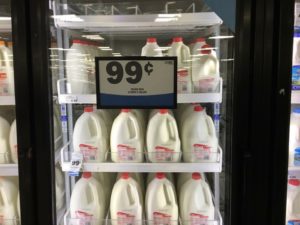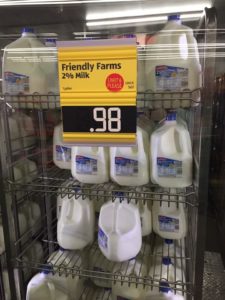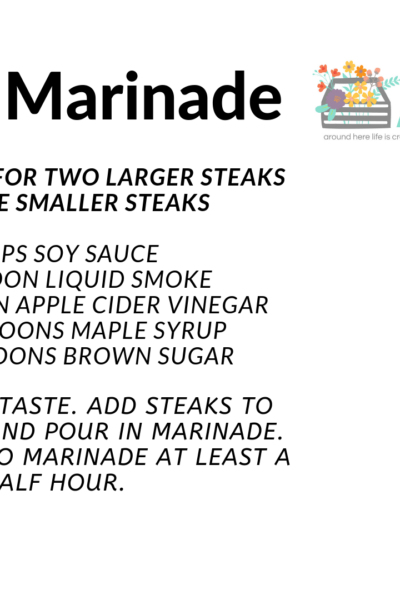I get asked this question about milk a lot. It has made me realize just how important it is to share and explain it. Unless you work in retail there is no reason why you would know how sales work. Today I am sharing why dairy is put on sale for such low prices and why it isn’t a bad thing.

Milk on sale for 99 cents at a Meijer. Photo courtesy of Carilynn Coombs
If you walk into a grocery store and you see milk for 99 cents a lot of questions can come to mind. For example, how can the store be making any money? How can the farmer be making any money?
When these sales are happening a gallon of milk is a loss leader. A loss leader is a fancy, gargon-y word for a sale. A store puts something popular on sale. That brings in lots of customers. Behind the scenes, the grocery store pays a set amount for dairy products. When they move more gallons of milk than normal they might get a volume discount. However, that price isn’t as low as the sale price. They are losing money on the gallon of milk.

Milk on sale for 98 cents in Iowa. Photo courtesy of Rhonda Bode Stoltzfus
You are probably wondering how they make money and don’t go out of business. Well, they make profit by making up with the other products you buy through the store. On everything else you buy, they have small amounts of profit built in to cover what it costs them to put dairy products on sale. The processor and dairy farmers are not taking a big hit in payment because it is on sale at your favorite grocery store. Depending on your state, you may have never found a gallon of milk on sale. Some states have a law that set a minimum price per gallon. One of the states I know definitely has this is North Dakota. If you want to see which state your milk comes from see this unique tool.
What else have you ever wondered while you are walking through the grocery store? I would love to answer any questions you might have!





Milk should be sold cheap because its almost a basic commodity; but 99 cents!
Milk is definitely a basic staple in most homes. It’s all about bringing customers into the store. As a dairy farmer, I look at it as the product I am making is in high demand.
I understand the marketing strategy behind offering a product on sale as a “loss leader.” What I don’t understand is the practice of pricing a half-size package of the product at way more than 50-60% of the price of the “full size” version. Although the price of milk seems very reasonable in my community right now, a few months ago it was much higher, and the price of a half-gallon was about 95% of the cost of a gallon – literally just a few cents less. I realize there are economies of scale, and don’t expect the price differential to be exactly 50%, since there are slight additional costs to package, ship, and shelve the half-gallon containers. I suspect those additional costs are less than 5%, but that’s just a hunch and I would welcome correction if my guess on that is way off. When a half-gallon of milk is priced within a few cents of the price of a gallon, some would suggest that everyone should just take the gallon since it is by far a better buy. But some people – I would be an example – don’t use a gallon of milk before it goes sour. Sometimes I don’t even use a half-gallon before it spoils. I could buy the gallon just for spite, knowing that I will pour at least half of it down the drain, but deliberately buying food I know will go to waste is not an ethical option for me. Who is getting this windfall – the farmer? the dairy? the grocer? I don’t mind subsidizing a bit more than the actual cost of packaging milk in half-gallons, just as I sometimes choose to pay more for a product to obtain higher quality or greater convenience. But it really grates on me to be exploited when a half-size quantity of a product is sold at 80% of the price of the larger size. I think a half-gallon and a full gallon of milk should both be considered “regular size” and priced accordingly.
I have often thought this. When I was a single lady who traveled a lot I bought a lot of half gallons and wondered why that price is so close to the gallon when it’s twice as much product. I’m actually visiting a grocery store for an event this weekend and I plan to ask this question!
My evil twin is thinking of making the rounds of major grocery stores in my area, grabbing a package each of chicken, beef and pork, and asking the good folks in the meat department just what antibiotics are found in the packages NOT labeled “antibiotic free.”
I’d also like to ask store management why the “non-GMO” products are (supposedly) better – especially if some are higher priced – but I know store personnel are probably not equipped to field that question, and I support offering choices including how food is produced. I just resent the fear-of-food garbage that is behind much of the labeling, particularly when there is not a “with GMO” equivalent, as is the case with the vast majority of packaged products on the grocery shelves. I’d like to see such labeling limited to foods that have both genetically engineered and non-engineered versions on the market.
I agree with all of this Elaine. I hate the fear that labels put into people’s mind. I know if I were in their shoes I would be the same way. It’s so easy to see that label and completely doubt what you might think!
The grocery store I go to most of the time is a Super Stop and Shop in Canaan, CT. There has been a grocery store at this location for years, but it was only five or six years ago that it was enlarged.
Canaan, officially the Town of North Canaan, is a small community of 3,000 or so residents. There is a large campgrounds near which brings in a lot of people during the summer and people from neighboring towns come, but I don’t think it’s a lot.
When I go I see so much produce and meats in the cases. Certainly they can’t be bought before “sell-by” date. I wonder what happens to these items. I hope they are donated to someone and not just thrown away.
That’s a great question! I will be looking into this for you. Thank you for bringing up this issue because I agree, I hope they donate it.